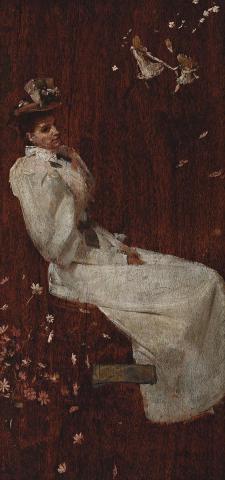PORTRAIT IN THE GARDEN, 1896
TOM ROBERTS
oil on wood panel
60.5 x 29.0 cm
signed and dated lower left: 1896. Tom Roberts.
Darlinghurst Galleries, Sydney (label attached verso)
The Estate of the late James O. Fairfax AC, New South Wales and Bridgestar Pty Ltd, Sydney
Looking at People, Perception in Australia Art, Sancta Sophia College, University of Sydney, Sydney, 1968, cat. 128
Topliss, H., Tom Roberts 1856 – 1931: A Catalogue Raisonné, Oxford University Press, Melbourne, 1985, cat. 273, vol. I, p. 149; vol. II, pl. 122 (illus.)
Tom Roberts’ portraits of women are striking in their elegance and beauty, whether they be the more formal Madame Pfund, c.1887 in the National Gallery of Victoria, or informal as in this charming Portrait in the Garden, 1896. His response to feeling and fashion, as illustrated in the National Gallery of Australia’s beautiful An Australian Native, 1888, is unrivalled among his contemporaries. Profiled and hatted in style, as in Portrait of Florence, c.1898, in the Art Gallery of New South Wales, the sensuous feel for flesh and fabric plays lightly over all. Paintings of inviting refinement, they reveal Roberts’ singular perception and mastery in painting the female figure and personality. Portrait in the Garden has the added attraction of an engaging informality and casual relaxation, its elegance heightened by the elongation of the panel on which it is painted.
The 1890s saw Roberts involved in a series of portraits, ‘Familiar faces and figures’, twenty-three being exhibited in the Society of Artists’ rooms, Sydney in late 1900. Of theatrical entrepreneur George Coppin (National Portrait Gallery, Canberra), violinist Johann Kruse (private collection), politician Andrew Garran (private collection), and Professor G. W. L. Marshall-Hall (Performing Arts Museum, Melbourne), among other like celebrities, they are all men.1 Nevertheless, they share with Portrait in the Garden the casual moment captured on unpainted panel, highlighting the singleness of the figure set within a rich, warm background. The textural contrasts between grained wood and paint provide further interest. Portraits of women among this group are special, that of the artist’s model Ada Furlong, c.1895 (Art Gallery of Western Australia) being another rare example.
Roberts’ use of the unprimed wood panel probably grew out of painting on cigar box lids for The 9 By 5 Impression Exhibition of 1889. His La Favorita, c.1889 took the name from the Manila Cigars stamp ‘La Favorita’ on the verso. While the influences of Whistler are apparent in Portrait in the Garden, much additional pleasure can be found in the spontaneous Impressionist moment combined with a delight in Japonaiserie and Aestheticism. The decorative is tinged with poetic nostalgia, as the reflective look on the sitter’s face is seemingly realised in the ‘thought bubble’ of the upper right. Here, a younger and much younger girl dance, holding hands, around a boy, to the scattering of other blossoms – redolent of the transience of youth, spring and flowers. It is said that the playground song of ‘Ring-a-Ring o' Roses’ first appeared in print in 1881. It was certainly known to Roberts, who produced the etching Ring O’Roses, c.1891–93 now in the National Gallery of Australia. His interest was such that he returned to the subject in London, painting Australian Pastoral, 1904–05 (National Gallery of Australia), the composition being based on the previously mentioned etching. While idyllic days of beauty, innocence and romance are paramount, Roberts was alive to contemporary fashion. As dresses reduced in volume with the narrowing of skirts, leg-o’-mutton sleeves reached their height by 1896. And crownless hats maintained their height with extravagant plumage and other effects. Gems of informality, these and other works illuminate this most successful time in Roberts’ career.
1. Topliss, H., op. cit., vol. 1, p. 21: ‘In the [exhibition] catalogue Roberts expressed his desire that they should be kept together as a group since they were of historical importance as a gallery of Australian ‘familiar faces and figures”’.
DAVID THOMAS
Former Director Art Gallery of South Australia, Bendigo Art Gallery, and Newcastle Art Gallery
